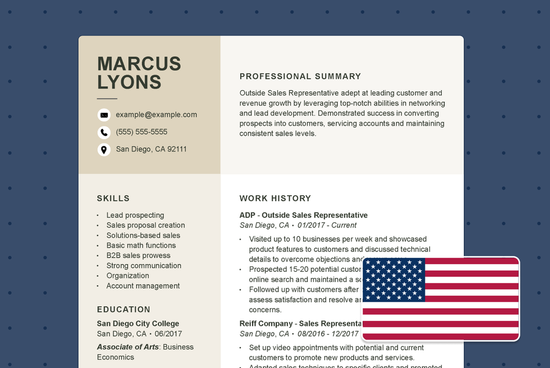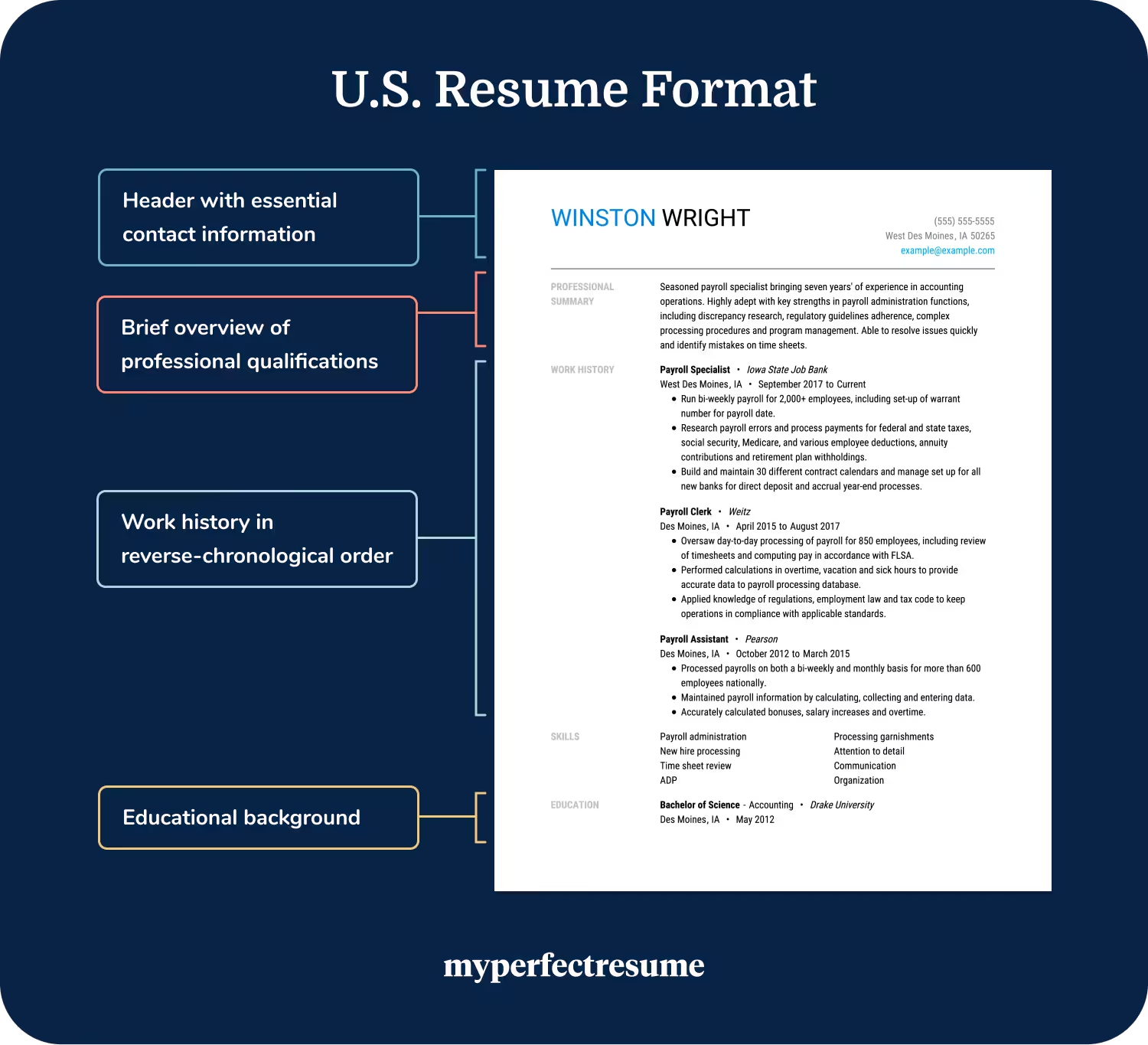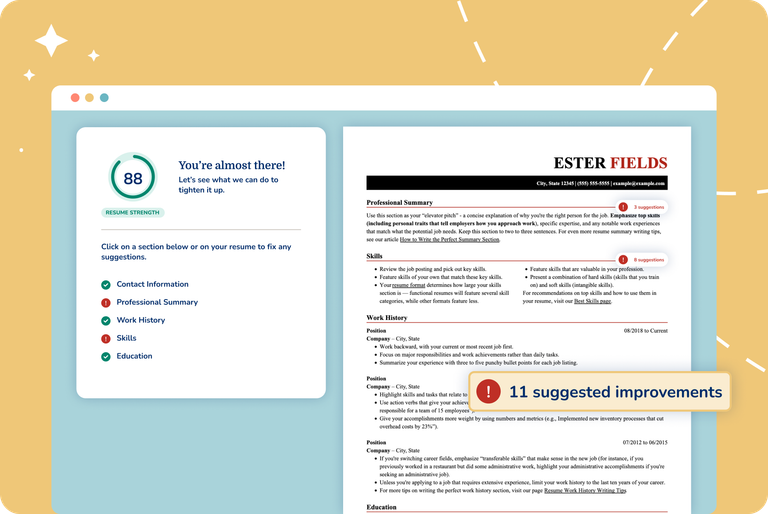U.S. Resume Format: How to Write an American Resume

Our customers have been hired at: *Foot Note
Ready to tackle the job market in the United States? The first step is to create a compelling resume that showcases your skills, experience and qualifications.
But with different cultural expectations and preferences, it's essential to understand what makes a U.S. resume stand out.
In this guide, we'll explore the key elements that employers look for on U.S. resumes and offer tips and tricks for writing a resume that gets noticed.
A U.S. resume is similar to a CV (curriculum vitae) but differs in terms of length and formatting. Explore everything you need to know about CVs vs. resumes to learn more.
What Is the Standard U.S. Resume Format?
There are three standard U.S. resume formats — the chronological resume, the functional resume and the combination resume.
The most popular American resume format is the chronological resume format, which highlights relevant work experience in reverse-chronological order.
Tailoring a chronological resume to fit the specific job you're applying for is crucial and showcases your most relevant experiences and achievements while demonstrating you understand the employer's needs.- Dr. Jasmine Escalera, Career Expert
In addition to following a reverse-chronological format, there are a few key elements to keep in mind as you format your U.S. resume:
- Stick to one to two pages in length. If you create a two-page resume, ensure that the entire second page is filled.
- Write your resume on a U.S. letter document (8.5” x 11”). Use 1-1.15” line spacing and 0.5”-1” margins on all sides.
- Choose a professional resume font such as Arial, Helvetica or Times New Roman. Use 10-12pt font size for body text and 14-16pt font size for headers.
- Incorporate bolding, italics and color consistently (i.e., if one header is bolded, every header should be bolded).
- Include clear section headings and ample white space between sections so that your resume is easy to scan.
Take a look at the resume example below to see how your resume should look. Notice the simple structure and subtle use of color to add interest without overwhelming the reader.
You can also use one of our professionally designed resume templates, which incorporate all of the formatting elements mentioned above.
When writing a U.S. resume, use American English spellings and language conventions. For instance, use "color" instead of "colour" or "center" instead of "centre."
What to Leave Off of a U.S. Resume
Certain elements should be left off a U.S.-format resume to follow the best practices American employers will be looking for.
A resume in the U.S. should not include any information that could potentially be used to discriminate against a job seeker. For example:
- A headshot or picture of yourself. While including a headshot is standard practice in some countries, it is uncommon and discouraged in the United States.
- Graphics or complex design elements that can prevent your resume from passing applicant tracking systems (ATS).
- References from past colleagues or managers. These can be provided if requested during the interview process.
- Personal information such as your age, marital status, ethnicity, religion or political affiliations.
- Your full street address. You do not need to include anything beyond your city and state (and your zip code if you choose to include it).
- Personal identification numbers, such as your social security number, driver’s license number or passport number.
- Immigration status or evidence of your employment eligibility. Employers cannot ask for this information before extending a job offer.
U.S. anti-discrimination laws play a significant role in determining what should not be included on your resume. These laws protect job seekers from discrimination based on factors such as age, race, gender, religion, disability and national origin.
By avoiding such information, job seekers can help ensure that their application is evaluated solely on their qualifications and merit.
If you want to clarify that you are applying from a different country or that you do not require employment sponsorship, you can write a cover letter that details your circumstances.
What to Include in Your U.S. Resume
Your U.S. resume should showcase your work history in reverse chronological order, a summary statement, relevant skills and educational background.
See the U.S. resume format sample below for a snapshot of the key sections to include in your resume, and read about the key components of each section.
Header with your contact information
Your U.S. resume template should start with a clear resume header that includes your contact information so that employers can reach out for an interview.
We recommend using our Resume Builder, which includes U.S. resume templates that feature a variety of header options crafted according to best practices in the United States.
When you apply for a job in the U.S., it is recommended to include a U.S. phone number on your resume if you have one. If you do not have a U.S. phone number, make sure to mention your country code and any necessary international dialing codes so that employers can easily contact you.
In addition to your phone number, you should include your full name, a professional email address, your current address (including your country of residence, if applicable), and a link to an online career profile or personal portfolio if it is relevant to the job.
Here is an example:
WINSTON WRIGHT
555-555-5555 | winston@email.com | West Des Moines, IA 50265 | example@example.com
Brief professional summary
Most U.S. resumes feature a profile or resume summary at the top that briefly details the key qualifications that make you uniquely suited for the role.
Here are a few tips to keep in mind when writing a summary for a U.S. resume:
- Highlight your unique value in three to five sentences.
- Use American English spelling and grammar conventions.
- Incorporate resume keywords from the job description if they fit naturally.
- Do not use first-person pronouns or passive voice.
- Use impactful yet simple language, avoiding unnecessary jargon.
Below is an example of a professional summary that effectively describes the candidate’s key skills and qualifications.
"Results-driven marketing professional with over five years of experience in developing and executing successful marketing campaigns for a variety of clients. Skilled in market research, brand development and digital marketing, with a proven track record of increasing brand awareness and driving sales. Highly organized and detail-oriented, with strong project management skills and the ability to collaborate effectively with cross-functional teams."
Work experience in reverse-chronological order
The work history section is the primary focus of a reverse-chronological U.S. resume. List your past roles starting from your most recent or current role and working backwards.
Only include roles that are relevant to the position you are applying for.
For example, if you are writing a software engineering resume, you may choose to omit experience like waitressing or dog walking since it does not relate to your target role.
- Start each bullet point with strong action verbs and maintain consistent verb tense throughout each section. For instance, use present tense for a current role and past tense for prior roles.
- Maintain parallel structure by using consistent patterns of words or phrases in a sentence or a series of sentences (i.e., “Developed marketing strategies, conducted market research and analyzed customer data” instead of “Developed and implemented marketing strategies while conducting market research and analyzing customer data”).
- Whenever possible, use numbers and figures to describe accomplishments on your resume, for example: “Implemented a new lead generation strategy, resulting in a 40% increase in qualified leads and a 15% increase in conversion rates.”
- Use active voice throughout your resume. For instance, instead of saying, “A new project was launched and managed by me, resulting in a 20% increase in productivity,” say, “Launched and managed a new project, resulting in a 20% increase in productivity.”
Here is an example of an effective work history entry on a U.S. resume:
WORK HISTORY
Marketing Manager
ABC Company, New York, NY
May 2020 - Present
- Develop and execute marketing strategies and campaigns across multiple platforms, including email, social media and events.
- Manage a team of three marketing coordinators, providing guidance and support to ensure successful project delivery and professional growth.
- Analyze market trends, customer needs and competitor activities to identify new business opportunities and develop product positioning and messaging.
An essential element of a U.S. resume is that it should be tailored to the job you are applying for, featuring the skills and qualifications that align with the role.
A targeted resume incorporates keywords and phrases from the job description, increasing the chances of passing ATS and impressing hiring managers.
We recommend using our ATS Resume Checker to scan for common errors that hinder your chances of passing ATS, such as a lack of measurable achievements or ineffective word choice.
Job-relevant skills
Create a separate resume skills section using bullet points to make it easy for the hiring manager to read and scan your resume. Here is an example:
SKILLS
- Google Analytics
- HTML and CSS
- Technical writing
- Social media management
- Search engine optimization
- Cross-team collaboration
Remember to tailor your skills section to the specific job requirements and consider the skills that will make you stand out as an international candidate who brings unique experiences and perspectives to the table. Here are a few considerations when writing the skills section of your U.S. resume:
- Feature U.S.-specific skills: Research the specific high-income skills that are in demand in the U.S. job market for your target role and include those that align with your experience and qualifications.
- Include a variety of skills: Feature a blend of hard skills and soft skills to demonstrate that you have a range of abilities and are adaptable to different work environments. Refer to the sample resume formats on this page for inspiration.
- Avoid jargon: Be mindful of using cultural references or jargon that may not be familiar to U.S. employers. Keep your language clear, concise and focused on the skills and qualifications that are directly relevant to the job you are applying for.
Employers look for candidates who have the skills needed to do the job they are hiring for. They also want someone who fits in well on the team and with the company. This is where transferable skills come in handy. Showing that you have transferable skills related to the role you are applying for increases a hiring team's confidence that you cannot only succeed in the role but thrive at the company.- Toni Frana, Career Expert
Educational background
Your U.S. resume should feature an education section towards the bottom that lists your college or university degree(s).
If you graduated more than 5-10 years ago, consider removing your graduation date from your resume unless it is specifically requested in the job application.
Unless you are a recent high school graduate with no college or higher education, it is generally unnecessary to include information about your high school education.
Here is an example education section for a U.S. resume:
EDUCATION
Bachelor of Science in Accounting
Drake University - Des Moines, IA
Optional resume sections
There are several optional sections that you can include on a U.S. resume, depending on your skills, experiences and the job you are applying for. Here are some examples:
- Certifications and licenses: A list of any certifications or licenses you have earned that are relevant to the job you are applying for.
- Awards and honors: A list of any awards or honors you have received, such as scholarships, academic awards or recognition from your previous employers.
- Volunteer experience: Information about any volunteer work you have done, including the organization, your role and the dates of your involvement.
- Professional memberships: Any professional organizations you belong to, including the name of the organization, your role and the dates of your membership.
Remember, the sections of your resume that you choose to include should be relevant to the job you are applying for and highlight your strengths and experiences.
We have a library of professionally designed basic resume templates to help you craft a simple yet effective U.S. resume.
U.S. Resume Template
Take a look at our professionally crafted U.S.-style resume to see what a standout American resume looks like.
We also recommend exploring our library of 800+ resume examples for real-world U.S. resume examples for different job titles, industries and circumstances.
This U.S. resume sample follows best practices such as listing work history in reverse-chronological order and incorporating value propositions into the summary.
The education section is relevant and focused, and the skills section provides a quick snapshot of the candidate's abilities.
Overall, this resume is a great example of how to effectively showcase your qualifications and stand out in a competitive job market.
Although not all employers in the U.S. require a cover letter, it’s generally a good idea to include one to expand on your resume and detail why you’re a great fit. Use our Cover Letter Generator to craft a compelling cover letter in minutes.
Key Takeaways
- Use a reverse-chronological resume format and stick to one or two pages.
- Do not include personal information such as your age, gender or marital status.
- Tailor each section of your resume to the job that you are applying for.
- Maintain a consistent format and do not include a headshot or complex graphics.
- Include a summary statement at the top that describes your unique value.
FAQ
What do recruiters want to see on a U.S. resume?
In addition to the standard resume sections, such as work experience, skills and education, recruiters typically look for the following on a U.S. resume:
- Tailoring to the job: Recruiters appreciate a resume that is tailored to the specific job they’re hiring for. Be sure to read the job description and customize your resume to highlight your relevant skills and experience.
- Continuous learning: Employers value candidates who are committed to ongoing learning and professional development. Highlight any relevant courses, certifications or industry involvement that demonstrates your commitment to self-improvement.
- Initiative and drive: Employers highly value showcasing your proactive nature and ability to take initiative. Highlight any projects you’ve initiated, process improvements you’ve implemented or accomplishments that demonstrate your drive.
Our AI Resume Builder offers professionally crafted templates and expert content suggestions so that you can craft a tailored resume in minutes.
Should a U.S. resume include a headshot?
In general, it is not customary to include a headshot on a U.S. resume. Although it is common practice in some countries to include a photo, it is not expected and even discouraged in the United States.
Only include a headshot if it is specifically requested in the job description, for example, if you are writing a fashion model resume.
If a company requires a headshot or a photo as part of the application process, they will usually specify this in the job posting or application instructions.
Check out what to put on a resume for additional U.S. resume guidance from career advice experts.
How do I format my resume for U.S. jobs?
The standard resume format in the United States is the reverse-chronological format.
This format emphasizes your work experience by listing your most recent job positions first, followed by previous positions in reverse chronological order.
If you just graduated from college or have minimal work experience, the functional resume format, which focuses on skills rather than work history, may be appropriate.
We recommend exploring the best AI resume builders for guidance on tools that you can use to take the guesswork out of creating your U.S.-format resume.
Should I include references on my resume?
No, it is unnecessary to include references on a resume in the United States. It is an outdated practice and is not recommended. Instead, you can provide a separate sheet of professional references after the interview if requested by the employer.
Make sure to choose references who can vouch for your skills and work experience. When providing references, ensure that you have obtained their permission to use their names and contact information.
Additionally, provide their current job title, email address and phone number. Finally, make sure to thank your references for their time and assistance.
Explore our Canadian resume and Australian resume guides if you want to keep your options open and apply for roles in different countries.
How long should a U.S. resume be?
Generally, a U.S. resume should be concise and limited to one or two pages.
However, the length of your resume can vary depending on your level of experience and the specific requirements of the job you are applying for.
If you have less than ten years of work experience or are a recent graduate, a one-page resume should be sufficient.
This allows you to highlight your most relevant qualifications and achievements without overwhelming the reader with excessive information.
If you have more extensive work experience or are applying for a senior-level position, a two-page resume is acceptable.
In fields such as academia, medicine, science, law and government, job seekers are often expected to submit a CV instead of a resume.
See how to make a CV for additional guidance from career experts.
Should I put U.S. citizenship on my resume?
Including U.S. citizenship on your resume is typically unnecessary unless it’s specifically relevant to the job. Most employers assume applicants are authorized to work in the U.S. if they’re applying.
Mentioning citizenship may unintentionally reveal information (e.g., nationality or ethnicity) that could lead to unconscious bias. If the job does not require specific work authorization, leave it off and focus on skills and experience.
If work authorization is relevant but you want to avoid directly stating citizenship: “Authorized to work in the U.S. without sponsorship.” This is professional and focuses on eligibility rather than personal details.
What is the U.S. version of a CV?
Internationally, the terms “CV” and “resume” are often used interchangeably, but in the U.S., they serve different purposes. In the U.S., resumes are typically used instead of CVs (Curriculum Vitae) for most job applications.
If you’re applying for a standard job in the U.S., use a resume unless explicitly asked for a CV. The U.S. standard resume is used for most job applications in business, healthcare, education, tech and other industries.
On the other hand, CVs are used in the U.S. for academic, research, scientific or specialized roles where a detailed list of qualifications is required.
Whether you are a student or a seasoned professional, we recommend exploring our Harvard resume guide for additional tips and template options.
How we reviewed this article
Since 2012, we have helped more than 11 million job seekers. We want to make your career journey accessible and manageable through our services and Career Center’s how-to guides and tips. In our commitment to bring you a transparent process, we present our Editorial Process.
Sources
- University of Southern California. Career Center. Resume Format Guidelines
- Cornell Graduate School. Article. Resumes and CVs
Our customers have been hired at:*Foot Note












